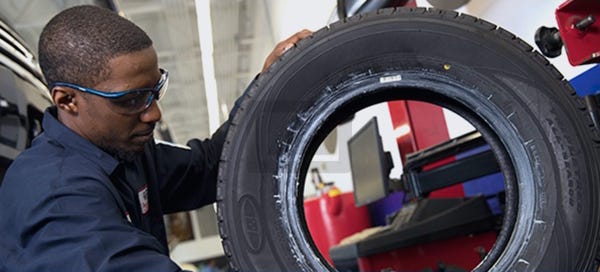Morris Tires: Your Partner for Expert GMC Tires Service
Morris Tires: Your Partner for Expert GMC Tires Service
Blog Article
Tire Service: The Effect of Weather
When it involves making certain optimal efficiency and safety on the road, recognizing the impact of weather on tire solution is critical. From scorching heat to icy roadways, each weather element can substantially affect tire capability and general driving experience. By diving right into the impacts of differing climate condition on tires, chauffeurs can gain valuable understandings that may improve their vehicle's performance and longevity. In this conversation, we will check out the detailed connection in between climate conditions and tire solution, shedding light on the importance of weather-specific tire maintenance practices and considerations.
Warm and Tire Performance
When subjected to heats, tires experience adjustments in efficiency that can dramatically influence car security and handling. The warm produced from long term driving or heat problems causes the tire rubber to soften, causing lowered walk life and enhanced wear. As the rubber becomes softer, the tire's grasp on the roadway lessens, influencing stopping distances and general grip. In extreme instances, extreme warmth can also trigger tire blowouts, presenting a severe safety and security threat to the car and its owners.

Cold Weather Effects
Cold weather conditions can have a substantial effect on tire efficiency and safety and security. In cold weather, tires might likewise lose air stress extra quickly, which can influence taking care of and gas efficiency.
To alleviate the results of winter on tires, it is critical to regularly check tire stress and inflate them to the manufacturer's recommended levels. Utilizing winter or all-season tires created for cool weather condition problems can likewise enhance traction and hold on icy or snowy roadways. Appropriate tire upkeep, consisting of routine evaluations for wear and damage, ends up being much more essential throughout cooler months to make sure ideal performance and security.
Rainy Conditions Influence
Tires with worn-out treads are extra susceptible to hydroplaning, where a layer of water builds up in between the roadway and the tire surface area, leading to loss of traction. To fight this, motorists should routinely check their tires for appropriate tread depth and think about spending in tires especially created for wet problems.
Additionally, rainy climate can likewise decrease visibility, making it testing for chauffeurs to see the road in advance clearly (GMC Tire Service). In such problems, it is vital to change driving rates as necessary and keep a safe complying go to my site with range to permit for sudden quits. Effectively inflated tires can additionally assist in maintaining control on wet roadways by giving far better handling and hold
Snow and Tire Security
When driving in snowy problems, having the appropriate tires can make a substantial difference in safety and security and performance. Winter season tires are developed with unique rubber compounds and tread patterns to give better grip on snow and ice contrasted to all-season tires.

It is vital to follow maker instructions when using and this link setting up tire chains to prevent damages to the tires and vehicle. By picking the appropriate tires, keeping proper inflation, and considering added grip aids like tire chains, motorists can enhance their safety and security when browsing snow-covered roads.
Weather-Related Tire Maintenance
Weather-related tire upkeep includes a variety of practices intended at making sure optimal tire function and longevity in various weather condition situations. One vital aspect of weather-related tire upkeep is tire pressure policy. Checking tire walk on a regular basis and changing tires when step wear gets to a specific depth is vital for maintaining traction and stability in unfavorable weather condition.
Final Thought
To conclude, climate problems have a significant influence on tire performance and security. From heat impacting tire stress and weblink put on to chilly weather decreasing traction, it is important to take into consideration the weather condition when keeping and using tires. Rainy conditions can reduce hold and bring about hydroplaning, while snow can boost the risk of mishaps if tires are not appropriately furnished. Weather-related tire maintenance is critical in making certain ideal performance and safety and security when driving.
In this conversation, we will certainly check out the complex relationship in between climate problems and tire solution, dropping light on the relevance of weather-specific tire upkeep practices and factors to consider.

Report this page